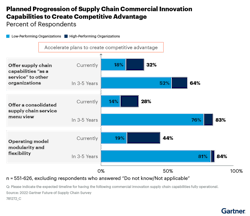Companies are starting to move beyond customer satisfaction and now aim to become more helpful to their customers. This advancement, called customer enablement by Gartner, Inc., will earn supply chain organizations repurchase orders, at a rate twice of those companies that don't provide this service, according to a new survey by the research group.
The survey also found that customer enablement is only being adopted by 23% of supply chain organizations today, but the strategy will become the norm within five years. The survey was comprised of 650 supply chain leaders across geography and industry from August to October 2022.
In five years, 80% to 90% of all supply chains plan to adopt the key components of these strategies across four areas, including commercial innovation, sustainability, real-time execution, and human-centric work design.
“The survey data showed that high-performing supply chain organizations are capturing competitive advantage and have capabilities at operational rates often twice as high compared to their lower-performing peers,” said Jennifer Loveland, senior director analyst with Gartner's Supply Chain proactive in a statement.
“These high-performing teams have also succeeded in retaining the respect of the C-Suite; 72% are viewed as strategic partners at a time when the perception of supply chain management’s importance has declined back to pre-pandemic levels at most organizations,” Loveland added.
Gartner identified high-performing supply chain organizations by rating their ability to exceed expectations on eight distinct measures over the past 12 months, including customer experience, stakeholder expectations and business performance, among other categories.
Different Strategies
As far as the commercial innovation strategy, Loveland comments that it "requires that there is no one-size-fits-all customer experience across the supply chain and no one-size-fits-every interaction for a specific customer.”
While generally supply chain leaders think of high, medium, or low-value product or customer segmentations as the primary way to differentiate supply chain service; enablement takes this further by looking at supply chain choices beyond cost, lead time and availability and differentiating experience order-to-order. Gartner notes that these specific strategies are being adopted at high-performing organizations at significantly higher rates today compared with their low-performing peers. And they believe that in three to five years these strategies will become mainstream.
The challenges of companies in reinventing commercial innovation strategies are operational and related to providing a differentiated supply chain experience as well as a lack of funding to pursue opportunities, the report notes.
“All organizations can start now to build a service menu that captures the current options available where customers interact with their supply chain,” said Loveland. “Rapid innovation to expand that service menu captures an earlier mover advantage, while ongoing innovation in specific categories such as supply chain as a service (SCaaS) offer opportunities for advantage even beyond five years.”
To identify areas of cost improvement and gain more funding, supply chain organizations across the board must emphasize cost transparency. A “cost-to-serve” model can help align supply chain costs to service choices, rather than functions, which provides better transparency and increases the chances of funding new commercial innovation strategies.




